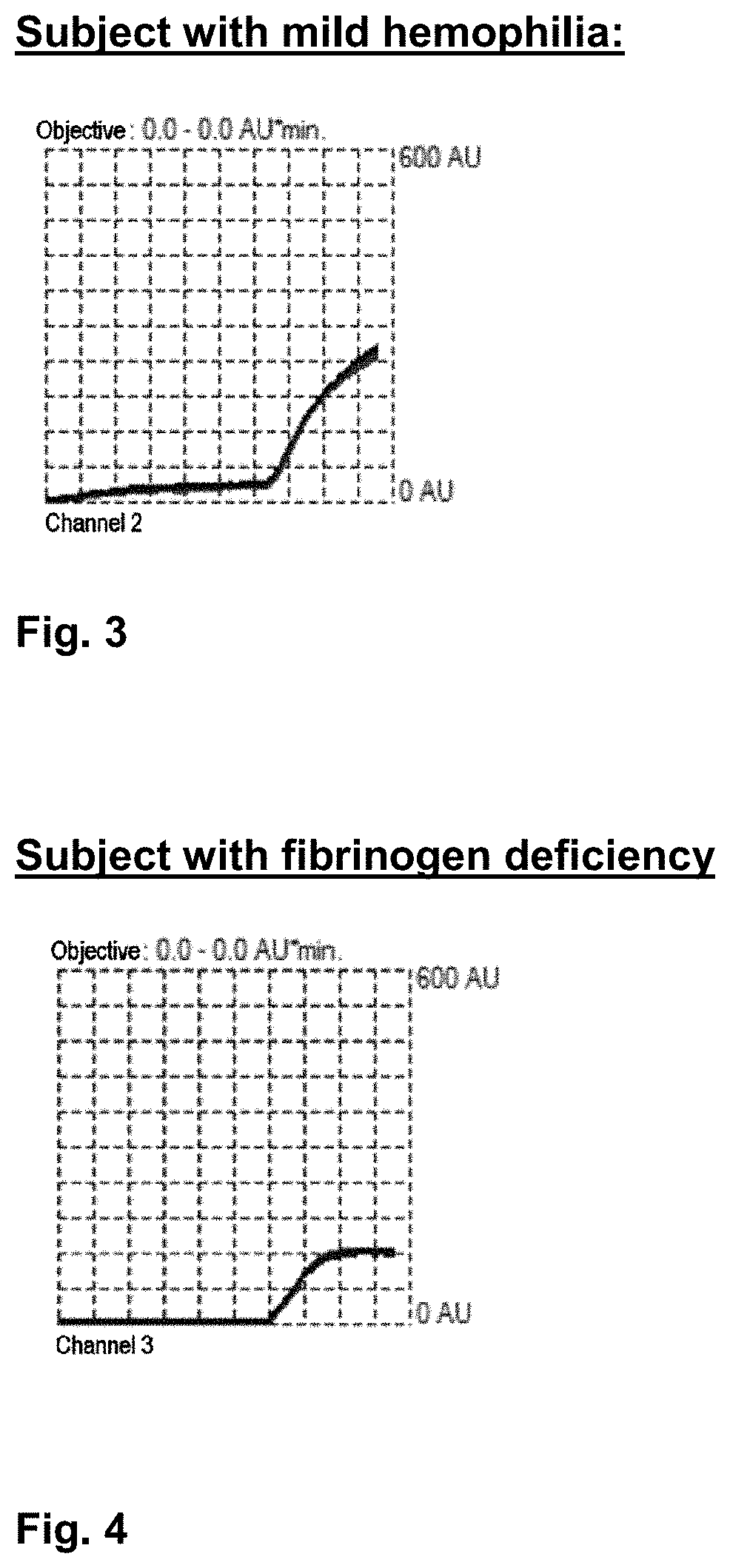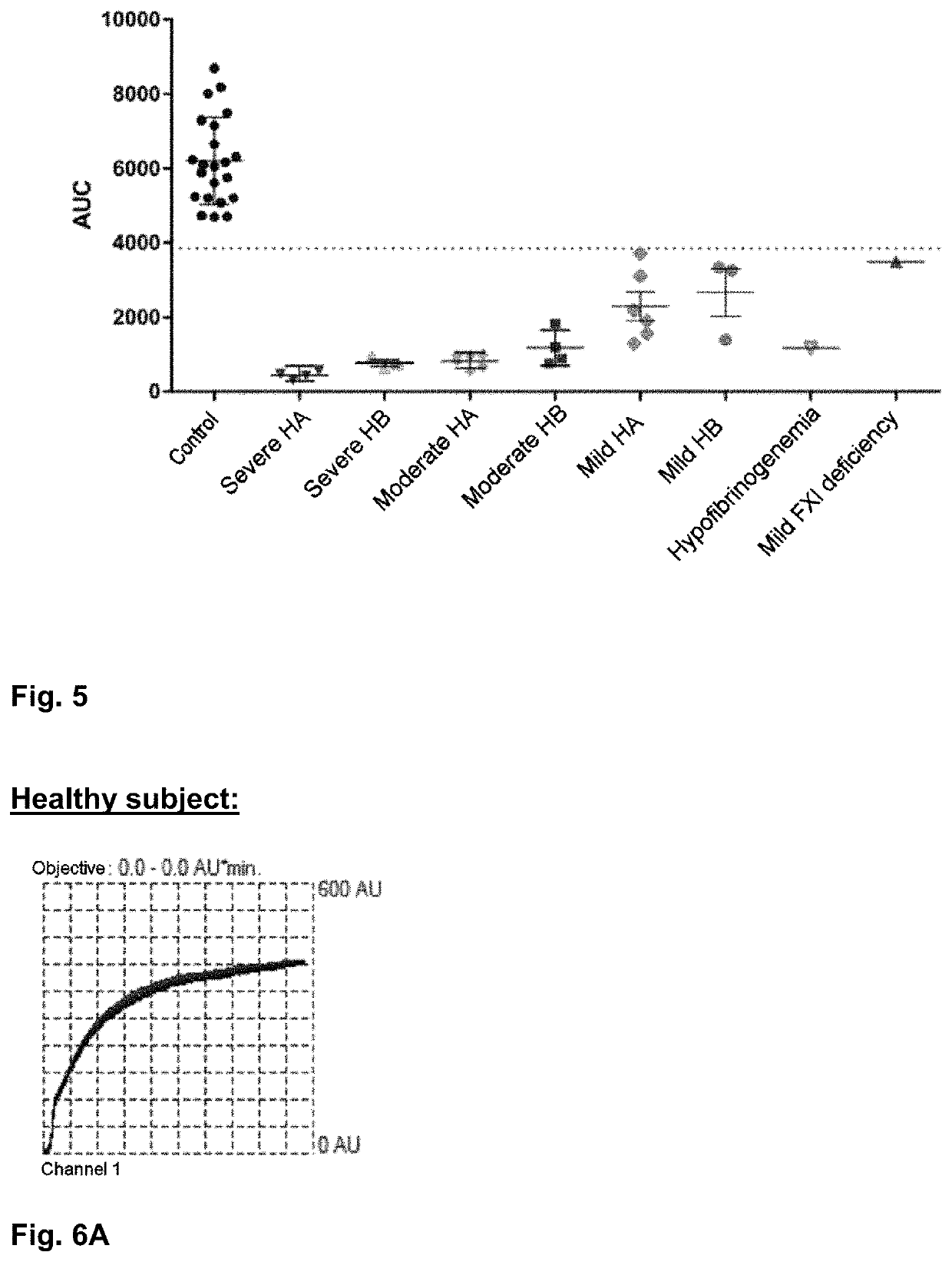Method for diagnosing anomalies in the coagulation blood
a technology of coagulation blood and anomalies, applied in the direction of material analysis, biological material analysis, instruments, etc., can solve the problems of lack of specificity, limited to experienced laboratories, lack of sensitivity for moderate diseases on the one hand, and the inability to carry out. , to achieve the effect of reducing the required sampling volum
- Summary
- Abstract
- Description
- Claims
- Application Information
AI Technical Summary
Benefits of technology
Problems solved by technology
Method used
Image
Examples
example 1
tal Protocol
[0185]300 μl of a solution of NaCl / CaCl2 (Roche Diagnostic) are placed in the cup before adding 300 μl taken from a citrated tube with a concentration of 0.107 M or 0.109 M. The cup is equipped with a magnetic bar for agitation and two pairs of silver electrodes connected to the Multiplate® unit (Roche Diagnostic).
[0186]After incubation for 120 seconds, clotting is initiated by adding a solution of tissue factor diluted in HEPES buffer; the final concentration in the sample is 2 pM (FIGS. 1 through 4), 100 pM (FIGS. 6A, 6B), or 1 pM (FIGS. 7A, 7B).
[0187]Measurement of the impedance variation between the electrodes (expressed in arbitrary units—AU) is carried out for a period of 20 minutes. A curve is thus generated as a function of time, and the curve thus obtained defines an area under the curve measured in AU / min (indicated in the figures as ‘AUC’).
example 2
btained by Adding Tissue Factor in a Concentration of 2 pM
[0188]FIGS. 1 through 4 respectively show the following:[0189]the curve obtained for a blood sample from a subject with no clotting disorders; the area under the curve is 4703 AU / min (FIG. 1.)[0190]the curve obtained for a blood sample from a subject diagnosed with severe hemophilia; the area under the curve is 301 AU / min. (FIG. 2.)[0191]the curve obtained for a blood sample from a subject diagnosed with mild hemophilia; the area under the curve is 2180 AU / min. (FIG. 3.)[0192]the curve obtained for a blood sample from a subject diagnosed with a fibrinogen deficiency; the area under the curve is 1173 AU / min. (FIG. 4.)
[0193]It may therefore be deduced from these curves that when the area under the curve is less than a threshold value referred to as a “reference value,” a clotting anomaly is present.
[0194]FIG. 5 shows the distribution of values for area under the curve as a function of the characteristics of the subjects tested....
example 3
t of Concentration of Tissue Factor Required for Initiating Clotting
[0201]Experiments were conducted according to the same protocol as that described in example 1 in order to determine the optimum concentration range of tissue factor sufficient to initiate blood clotting in vitro in the test described in the present application.
[0202]Two concentrations were tested: 100 pM and 1 pM, in two types of blood samples: one from a healthy subject without a clotting anomaly (A) and the other from a subject with moderate hemophilia.
[0203]When clotting is initiated with a concentration of 100 pM of tissue factor, the values for area under the curve are elevated and distinguishable between the two subjects:[0204]17,191 AU / min for a healthy subject with no clotting disorder;[0205]11,638 AU / min for a subject with hemophilia. (FIG. 6A, 6B)
[0206]When clotting is initiated with a concentration of 1 pM of tissue factor, the values for area under the curve are less elevated and are more sharply distin...
PUM
| Property | Measurement | Unit |
|---|---|---|
| volume | aaaaa | aaaaa |
| volume | aaaaa | aaaaa |
| temperature | aaaaa | aaaaa |
Abstract
Description
Claims
Application Information
 Login to View More
Login to View More - R&D
- Intellectual Property
- Life Sciences
- Materials
- Tech Scout
- Unparalleled Data Quality
- Higher Quality Content
- 60% Fewer Hallucinations
Browse by: Latest US Patents, China's latest patents, Technical Efficacy Thesaurus, Application Domain, Technology Topic, Popular Technical Reports.
© 2025 PatSnap. All rights reserved.Legal|Privacy policy|Modern Slavery Act Transparency Statement|Sitemap|About US| Contact US: help@patsnap.com



